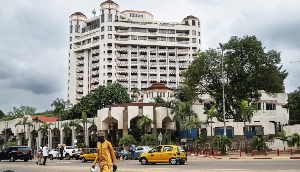Cameroon's target to triple cocoa production to attain the level of world's top three producers within a decade is being hampered by failure to adopt new trends in managing plantations as well as attracting young farmers to the sector.
High cocoa demand, particularly in Asia, is expected to inflate demand for cocoa in the $100 billion chocolate industry by about 1 million tonnes, or around a quarter of world production, by 2020.
Forecast deficits pushed world prices high up last week despite bumper crops from Ivory Coast and Ghana, the world's top two producers.
Cameroon, the fifth-biggest grower, earns 250 billion CFA francs ($523 million) a year from cocoa, accounting for about half its primary-sector exports. To ride the growth in demand, it aims to boost output to 600,000 tonnes per year by 2020, but industry experts and farmers are sceptical.
Cameroon's cocoa output has been irregular. It has wavered between record production and sharp drops in recent years blamed on poor weather, disease outbreaks and lack of farming inputs.
Losses due to disease and pests attacks has recorded between 30 and 40 percent according to the industry regulator, the National Cocoa and Coffee Board (NCCB).
It forecasts output at 235,000 tonnes this season, although pan-African bank Ecobank said in a research noted in March that production will likely slip again to about 190,000 tonnes. Exports were down 26.5 percent year-after-year in May.
NCCB General Manager Michael Ndoping said increased fertiliser use, sustainable farm management and quality control could easily add 50 percent to crop yield hence "Six hundred thousand tonnes can be achieved provided the resources required are in place, which is not the case for now," he said.
SLOW IMPLEMENTATION At the heart of Cameroon's ambitious plan is a drive to rejuvenate its trees, many of which are a half-century old. "We're recording huge losses with the current crop variety," said Remi Martial Avouzo'o, who farms in Ebolowa in southern Cameroon. Avouzo'o said that over the last two seasons, his output has dropped by 30 percent as disease ravaged his trees and harsh weather dried up flowers and the small pods.
The government sees a solution in the Biofabrica growing technique developed by Brazil's cocoa research institute CEPLAC, which selects and nurtures millions of disease-resistant high-yield cocoa seedlings for planting.
Widespread use of the technique has potential to boost Cameroon's cocoa yields from 300-500 kg per hectare to around 2 to 3 tonnes per hectare, said Jerome Mvondo, head of Cameroon's Cocoa Development Authority (SODECAO). But implementation has been slow, raising doubts about the government's commitment. When the project was announced in 2009, the government said it would invest $10 million on 20 million seedlings in the first year alone. But five years down the line, only a handful of nurseries have been established.
"It's practically impossible for us to meet the target of tripling output to 600,000 tonnes by 2020 given the state of things," said an official in the agriculture ministry, who requested anonymity.
Trees require six years to hit peak production and for Cameroon to reach its target, the programme should have been running at capacity: "This has not been the case," he said.
A Europe-based exporter who buys Cameroonian cocoa blamed a lack of consistency on the part of the government."They have to make a programme and stick to it," said the exporter, who also asked not to be identified. "What they are doing now is a little bit here, a little bit there. There is a lot of lip service and it is as if they don't know what to do."
FEW YOUTHS Even successful implementation of Cameroon's plan to rejuvenate plantations would likely not be enough to avoid looming stagnation, some industry people warned.
"Cameroon's cocoa sector has too many problems," said Simon Bassanaga, coordinator for CONACFAC, which groups farmers' cooperatives and agro-pastoral federations. "We need to completely restructure it or we're heading for a crisis."
In a country where the average population age is about 18 years, a study by the Cocoa and Coffee Interprofessional Council (CCIC) found that the average age of farmers ranged from 63 to 70 years depending on the region.
"Young people today always think that they can achieve success in life in an office in town," said Emmanuel Akolo, a 49-year-old farmer in the Centre Region, who quit university in 1987 to grow cocoa. Akolo heads a cooperative of some 400 farmers and said most young people were unaware of government-backed incentives aimed at drawing them into the cocoa sector.
The CCIC launched its "New Generation" scheme in 2012 to attract young people into cocoa farming and create new plantations by funding agricultural schools and giving logistical and financial help to the new farmers. While 500 hectares of new plantations have been created under the programme and some 325 youth farmers have participated, such efforts have not yielded substantial results.
SUSTAINABILITY The cocoa sector is trapped in a vicious cycle. Ageing trees and a lack of investments have driven down yields resultantly reducing volumes produced and thus farmer incomes. the Quality of beans is also another concern. Cameroonian beans sell at a discount of about 400 CFA francs ($0.83) per kg compared with their peers, according to Ecobank.
"Cameroon's cocoa is sometimes unfit for consumption. Farmers often dry it on tarred roads and beans are not fermented," Bassanaga said. "It is necessary to train farmers to produce quality and not only quantity." Improving quality would raise incomes, attract new farmers who would have money to invest in their plantations.
The NCCB regulator has pledged to invest 1.7 billion CFA francs to rehabilitate 2,500 cocoa dryers in the main growing areas to reduce the presence of smoke in beans and reinforce controls in an effort to meet tougher EU quality standards.
However, as the industry gears towards sourcing only certified traceable cocoa from sustainable farms by 2020, many worry that the poorest farmers may not be able to afford the required investments and could be left behind.
A possible solution, said Pim Van de Langenberg, head of the Dutch cocoa trading company Theobroma, would be for buyers to play a greater stock from farms to export as well as to guarantee stable supply.
Theobroma has partnered with 2,500 Cameroon cocoa farmers. It will provide them with financing to enable the production of 4,000 tonnes of certified cocoa for the firm.
"We need to stop talking and start acting," de Langenberg said. "Being a cocoa trader, you want to be prepared for the future. So you have to start looking at ways of getting sustainable cocoa."
Infos Business of Tuesday, 15 July 2014
Source: yahoonews













